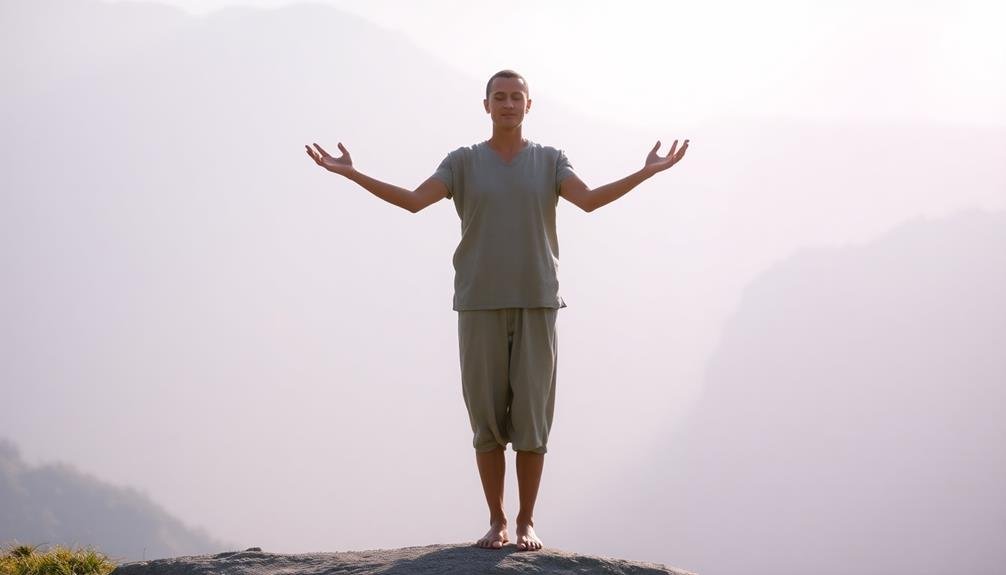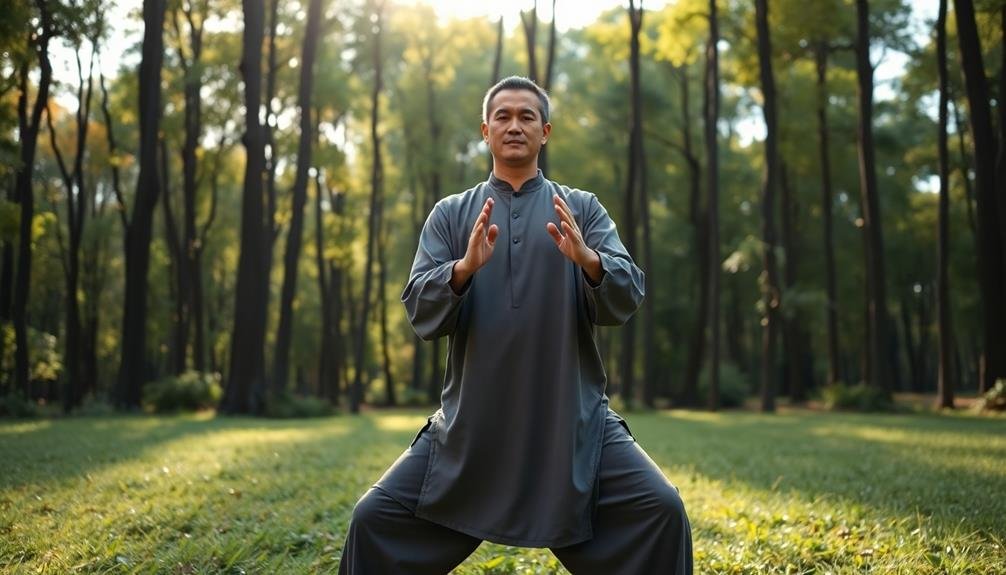Harness the power of Qigong to quickly ease your anxiety with these five effective moves. Start with "Shaking the Tree," mimicking a swaying motion to promote relaxation. Then, try "Standing Like a Mountain" to embody strength and stability. The "Grounding Palm Press" helps you connect deeply with the earth, channeling energy through your palms. For gentle self-soothing, practice the "Butterfly Hug" by tapping your shoulders rhythmically. Finally, immerse yourself in the "Flowing Water Meditation," visualizing your worries dissolving into a tranquil stream. These accessible techniques offer rapid relief and can build long-term resilience against stress and anxiety. Discover how these ancient practices can transform your daily life.
Key Takeaways
- Shaking the Tree mimics wind-swayed trees, promoting relaxation through fluid swaying motions and deep breathing.
- Standing Like a Mountain cultivates inner strength and stability, enhancing resilience against anxiety through mindful posture.
- Grounding Palm Press reduces anxiety by connecting with earth energy, using downward palm presses and focused breath work.
- Butterfly Hug provides quick anxiety relief through rhythmic shoulder tapping, engaging both brain hemispheres and promoting self-soothing.
- Flowing Water Meditation uses visualization to mentally escape anxiety, imagining worries dissolving in a peaceful stream.
Shaking the Tree

Out from the roots up to the branches, the Shaking the Tree qigong move mimics a tree swaying in the wind. This gentle, flowing exercise helps release tension and anxiety throughout your body.
Start by standing with your feet shoulder-width apart, knees slightly bent. Imagine your feet are rooted deep into the ground.
Begin to sway your body from side to side, allowing your arms to hang loosely. As you move, let the motion travel up from your feet through your legs, hips, torso, and finally to your arms and head. Keep your movements fluid and natural, as if you're being gently blown by a breeze.
As you sway, focus on your breath. Inhale deeply through your nose as you move to one side, and exhale slowly through your mouth as you move to the other. Feel the tension leaving your body with each exhale.
Continue this rhythmic swaying for 3-5 minutes, or until you feel a sense of calm washing over you.
This qigong move helps reset your nervous system, promoting relaxation and reducing anxiety. It's a simple yet effective technique you can use anytime, anywhere to quickly center yourself and find balance.
Standing Like a Mountain

The Standing Like a Mountain qigong pose embodies strength, stability, and inner calm. To practice this move, stand with your feet shoulder-width apart, knees slightly bent. Imagine roots growing from your feet deep into the earth, anchoring you firmly. Keep your spine straight but relaxed, and let your arms hang loosely at your sides.
Take slow, deep breaths, focusing on your lower abdomen expanding with each inhalation. As you exhale, visualize tension and anxiety leaving your body. Maintain this posture for at least five minutes, or longer if you're comfortable. If your mind wanders, gently bring your attention back to your breath and the sensation of being rooted to the ground.
This pose helps cultivate a sense of inner strength and resilience. As you practice, you'll likely notice your thoughts slowing down and your body becoming more relaxed.
It's an excellent technique to use when you're feeling overwhelmed or anxious, as it helps you reconnect with your inner stability. Regular practice can improve your overall sense of balance, both physically and emotionally, making you better equipped to handle life's challenges.
Grounding Palm Press

While Standing Like a Mountain roots you to the earth, the Grounding Palm Press takes that connection a step further. This powerful qigong move helps you channel energy through your palms, creating a sense of stability and calm.
To perform the Grounding Palm Press:
- Stand with feet shoulder-width apart, knees slightly bent.
- Raise your arms to chest height, palms facing down.
- Slowly press your palms downward, imagining you're pushing against an invisible force.
- As you press, exhale deeply and feel the energy flowing from your core to your palms.
- Hold the position for 5-10 seconds, then slowly release and inhale.
- Repeat 5-10 times, focusing on your breath and the energy flow.
| Benefits | Variations | Common Mistakes |
|---|---|---|
| Reduces anxiety | Eyes closed | Tense shoulders |
| Improves focus | Seated position | Shallow breathing |
| Enhances balance | One hand at a time | Rushing the movement |
| Increases energy flow | Add gentle bouncing | Locking knees |
| Promotes grounding | Combine with affirmations | Neglecting breath |
Butterfly Hug

Anxiety's grip often manifests in physical tension, but the Butterfly Hug technique offers a gentle release. This self-soothing method, developed by therapist Lucina Artigas, combines bilateral stimulation with mindful breathing to calm your nervous system.
To perform the Butterfly Hug:
- Cross your arms over your chest, placing your right hand on your left shoulder and your left hand on your right shoulder.
- Close your eyes and take a deep breath, focusing on the sensation of your hands on your body.
- Alternate tapping your hands on your shoulders, creating a slow, steady rhythm.
- Continue this motion for 1-2 minutes, breathing deeply and allowing tension to melt away.
As you practice the Butterfly Hug, you'll notice a gradual sense of calm washing over you. The rhythmic tapping helps ground you in the present moment, while the cross-body movement engages both hemispheres of your brain.
This technique is particularly effective during moments of acute anxiety or when you're feeling overwhelmed. You can discreetly perform it anywhere, making it a versatile tool for managing anxiety in various situations.
Flowing Water Meditation

Moving from physical touch to the power of visualization, the Flowing Water Meditation offers a serene mental escape from anxiety. Begin by finding a comfortable seated position and closing your eyes. Imagine yourself sitting beside a gently flowing stream, surrounded by lush greenery and the soothing sounds of nature.
Visualize the clear water as it moves past you, carrying away your worries and tension. With each breath, picture your anxiety dissolving into the stream and being swept downstream. As you continue this meditation, focus on the sensations you'd experience in this peaceful setting:
| Sight | Sound | Feeling |
|---|---|---|
| Sparkling water | Bubbling brook | Cool breeze |
| Swaying trees | Rustling leaves | Soft grass |
| Blue sky | Chirping birds | Warm sunlight |
| Colorful flowers | Gentle wind | Inner calm |
Allow yourself to be fully immersed in this tranquil scene for 5-10 minutes. When you're ready to conclude, slowly open your eyes and carry the sense of peace with you throughout your day. Practice this meditation regularly to build resilience against anxiety and stress.
Frequently Asked Questions
How Long Should I Practice Qigong Daily for Optimal Anxiety Relief?
You'll benefit most from practicing qigong for 15-30 minutes daily. Start with shorter sessions and gradually increase. Consistency is key, so find a time that works for you and stick to it. You'll notice improvements over time.
Can Qigong Be Combined With Other Anxiety Management Techniques?
Yes, you can combine qigong with other anxiety management techniques. You'll find it complements practices like meditation, deep breathing, and cognitive behavioral therapy. It's effective to integrate qigong into a holistic approach for managing your anxiety.
Are There Any Potential Side Effects of Practicing Qigong?
You're unlikely to experience side effects from qigong, but you might feel dizzy or lightheaded if you're new to it. Don't overexert yourself, and stop if you feel uncomfortable. Always consult your doctor before starting any new exercise routine.
Is Qigong Suitable for All Age Groups and Fitness Levels?
You'll find qigong suitable for most age groups and fitness levels. It's gentle and adaptable, so you can adjust the intensity to your needs. Whether you're young or old, fit or not, you can benefit from qigong practice.
How Soon Can I Expect to See Results From Regular Qigong Practice?
You'll likely notice some benefits within a few weeks of regular practice. However, everyone's experience is different. Consistency is key. You may feel more relaxed and centered after just a few sessions. Stick with it for best results.
In Summary
You've now learned five potent qigong moves to quickly calm your anxiety. By incorporating these practices into your daily routine, you'll build a powerful toolkit for managing stress. Remember, consistency is key. Start with just a few minutes each day and gradually increase your practice time. As you become more familiar with these techniques, you'll find it easier to tap into their calming effects whenever anxiety strikes. Give yourself the gift of inner peace through qigong.





Leave a Reply